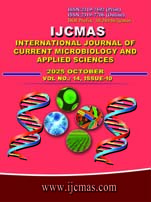


 National Academy of Agricultural Sciences (NAAS)
National Academy of Agricultural Sciences (NAAS)

|
PRINT ISSN : 2319-7692
Online ISSN : 2319-7706 Issues : 12 per year Publisher : Excellent Publishers Email : editorijcmas@gmail.com / submit@ijcmas.com Editor-in-chief: Dr.M.Prakash Index Copernicus ICV 2018: 95.39 NAAS RATING 2020: 5.38 |
The emergence of multidrug-resistant Gram-negative bacteria underscores the need for antibiotics with novel mechanisms of action. The essential β-barrel assembly machinery (BAM) complex, which is crucial for the biogenesis of outer membrane proteins (OMPs), represents as a promising therapeutic target. In this study, we investigate the potential role of CaNCR63, a nodule-specific cysteine-rich (NCR) peptide derived from chickpea (Cicer arietinum), as a novel inhibitor of BamA complex. Using a multi-step computational approach, we confirmed CaNCR63’s antimicrobial peptide-like physicochemical characteristics and the presence of a conserved γ-core motif, justifying its selection. Comparative molecular docking between CaNCR63 and darobactin against the E. coli BAM complex showed a high-affinity binding configuration for CaNCR63 at the functionally significant lateral gate of BamA, a site also targeted by the known antibiotic darobactin. To validate this static model, a 100 ns all-atom molecular dynamics simulation of the CaNCR63-BamA complex within a model bacterial membrane was conducted. The simulation verified the formation of a dynamically stable complex, marked by a persistent network of intermolecular contacts and hydrogen bonds. Binding free energy calculations (MM/PBSA) suggested a strong, sub-nanomolar binding affinity (?Gbind = -12.75 kcal/mol), predominantly driven by electrostatic interactions. Additionally, analysis of system’s dynamics showed that CaNCR63 binding allosterically modulates the flexibility of the entire BAM complex, limiting the conformational plasticity of the lateral gate. Collectively, these findings provide a cohesive, multi-scale model suggesting that CaNCR63 functions as a darobactinlike inhibitor by physically locking the lateral gate, thereby impeding the OMP assembly process. This research supports the potential of plant-derived NCR peptides as a promising chemical framework for developing new antibiotics targeting Gram-negative pathogens.
Abban, Molly Kukua et al., (2023). “The burden of hospital acquired infections and antimicrobial resistance”. In: Heliyon 9.10. https://doi.org/10.1016/j.heliyon.2023.e20561.
Blair, Jessica MA, Grace E Richmond, and Laura JV Piddock (2014). “Multidrug efflux pumps in Gram-negative bacteria and their role in antibiotic resistance”. In: Future microbiology 9.10, pp. 1165–1177.
Chan-Tompkins, Noreen H (2011). “Multidrug-resistant gram-negative infections”. In: Critical Care Nursing Quarterly 34.2, pp. 87–100.
Di Somma, Angela et al., (2022). “The antimicrobial peptide Magainin-2 interacts with BamA impairing folding of E. coli membrane proteins”. In: Frontiers in Chemistry 10, p. 1013788.
Dincer, Sad?k, F Masume Uslu, and Anil Delik (2020). “Antibiotic resistance in biofilm”. In: Bacterial biofilms 10, p. 9.
Fatima, Zeeshan et al., (2023). “Multidrug resistance: a threat to antibiotic era”. In: Biological and Environmental Hazards, Risks, and Disasters. Elsevier, pp. 197–220.
Fingerhut, L et al., (2020). “ampir: An R package for fast genome-wide prediction of antimicrobial peptides”. In: Bioinformatics 36.24, pp. 5720–5721. https://doi.org/10.1093/bioinformatics/btaa1048.
Gopinath, Aathira and Benesh Joseph (2022). “Conformational flexibility of the protein insertase BamA in the native asymmetric bilayer elucidated by ESR spectroscopy”. In: Angewandte Chemie International Edition 61.2, e202113448.
Gu, Yan et al., (2016). “Structural basis of outer membrane protein insertion by the BAM complex”. In: Nature 531.7592, pp. 64–69. https://doi.org/10.1038/nature17199.
Haysom, Samuel F. et al., (2023). “Darobactin B Stabilises a Lateral-Closed Conformation of the BAM Complex in E. coli Cells”. In: Angewandte Chemie International Edition 62.34, e202218783. https://doi.org/10.1002/anie.202218783.
Imai, Yu et al., (2019). “A new antibiotic selectively kills Gram-negative pathogens”. In: Nature 576.7787, pp. 459–464.
Kaur, Hundeep et al., (2021). “The antibiotic darobactin mimics a β-strand to inhibit outer membrane insertase”. In: Nature 593.7857, pp. 125–129.
Kuo, Katie M. et al., (2023). “Drug Binding to BamA Targets Its Lateral Gate”. In: The Journal of Physical Chemistry B 127.34, pp. 7509–7517. https://doi.org/10.1021/acs.jpcb.3c04501.
Lima, Rui M et al., (2022). “Legume Plant Peptides as Sources of Novel Antimicrobial Molecules against Human Pathogens”. In: Frontiers in Molecular Biosciences 9, p. 870460. https://doi.org/10.3389/fmolb.2022.870460.
Masi, Muriel, Matthieu R´efregiers, Klaas M Pos, et al., (2017). “Mechanisms of envelope permeability and antibiotic influx and efflux in Gram-negative bacteria”. In: Nature microbiology 2.3, pp. 1–7.
Montiel, J. et al., (2017). “Morphotype of bacteroids in different legumes correlates with the number and type of symbiotic NCR peptides”. In: Proceedings of the National Academy of Sciences USA 114.19, pp. 5041–5046. https://doi.org/10.1073/pnas.1704217114.
Noinaj, Nicholas, James C Gumbart, and Susan K Buchanan (2017). “The β-barrel assembly machinery in motion”. In: Nature Reviews Microbiology 15.4, pp. 197–204.
Oliveira Maciel, S C de, A´ S Pires, and O L Franco (2017). “AmpGram: a platform for computational analysis of antimicrobial peptides”. In: Scientific Reports 7.1, p. 5797. https://doi.org/10.1038/s41598-017-06225-z.
Peterson, Janine H, Matthew Thomas Doyle, and Harris D Bernstein (2022). “Small molecule antibiotics inhibit distinct stages of bacterial outer membrane protein assembly”. In: Mbio 13.5, e02286–22.
Pirtskhalava, M et al., (2021). “DBAASP v3: database of antimicrobial/cytotoxic activity and structure of peptides as a resource for development of new therapeutics”. In: Nucleic Acids Research 49.D1, pp. D288–D297. https://doi.org/10.1093/nar/gkaa991.
Ritzmann, Noah et al., (2022). “Monitoring the antibiotic darobactin modulating the β-barrel assembly factor BamA”. In: Structure 30.3, pp. 350–359.
Roy, Proyash et al., (2020). “Symbiotic outcome modified by the diversification from 7 to over 700 nodule-specific cysteine-rich peptides”. In: Genes 11.4, p. 348.
Sabtu, N, DA Enoch, and NM Brown (2015). “Antibiotic resistance: what, why, where, when and how?” In: British medical bulletin 116.1, pp. 105–113.
Schaenzer, Adam J and Gerard D Wright (2020). “Antibiotic resistance by enzymatic modification of antibiotic targets”. In: Trends in molecular medicine 26.8, pp. 768– 782.
Seyfert, Carsten E et al., (2023). “Darobactins exhibiting superior antibiotic activity by Cryo-EM structure guided biosynthetic engineering”. In: Angewandte Chemie International Edition 62.2, e202214094.
Srinivas, Nityakalyani et al., (2010). “Peptidomimetic antibiotics target outer-membrane biogenesis in Pseudomonas aeruginosa”. In: Science 327.5968, pp. 1010–1013.
Storek, Kelly M et al., (2018). “Monoclonal antibody targeting the β-barrel assembly machine of Escherichia coli is bactericidal”. In: Proceedings of the National Academy of Sciences 115.14, pp. 3692–3697.
Thorpe, Kenneth E, Peter Joski, and Kenton J Johnston (2018). “Antibiotic-resistant infection treatment costs have doubled since 2002, now exceeding 2billionannually”. In: Health Affairs 37.4, pp. 662–669.
Tiricz, Hilda et al., (2013). “Antimicrobial nodule-specific cysteine-rich peptides induce membrane depolarization-associated changes in the transcriptome of Sinorhizobium meliloti”. In: Applied and Environmental Microbiology 79.21, pp. 6737–6746.
Trigg, Alexandra Elizabeth (2023). “Multiple antibiotic resistance in gram-negative bacteria: controlling cell envelope barrier function”. PhD thesis. University of Birmingham.
Urfer, Matthias et al., (2016). “A peptidomimetic antibiotic targets outer membrane proteins and disrupts selectively the outer membrane in Escherichia coli”. In: Journal of Biological Chemistry 291.4, pp. 1921–1932.
Vardakas, Konstantinos Z and Matthew E Falagas (2017). “Colistin versus polymyxin B for the treatment of patients with multidrug-resistant Gram-negative infections: a systematic review and meta-analysis”. In: International journal of antimicrobial agents 49.2, pp. 233–238.
Vij, Rajesh et al., (2018). “A targeted boost-and-sort immunization strategy using Escherichia coli BamA identifies rare growth inhibitory antibodies”. In: Scientific Reports 8.1, p. 7136.
Waghu, F H et al., (2016). “CAMPR3: a database on sequences, structures and signatures of antimicrobial peptides”. In: Nucleic Acids Research 44.D1, pp. D1094–D1097. https://doi.org/10.1093/nar/gkv1051.
Walker, Morgan E et al., (2025a). “Antibacterial macrocyclic peptides reveal a distinct mode of BamA inhibition”. In: Nature Communications 16.1, p. 3395.
Walker, Morgan E. et al., (2025b). “Antibacterial macrocyclic peptides reveal a distinct mode of BamA inhibition”. In: Nature Communications 16.1, p. 58086. https://doi.org/10.1038/s41467-025-58086-w.
Wang, G, X Li, and Z Wang (2016). “APD3: the antimicrobial peptide database as a tool for research and education”. In: Nucleic Acids Research 44.D1, pp. D1087–D1093. https://doi.org/10.1093/nar/gkv1278.
Xu, Qian, Min Guo, and Feiyuan Yu (2023). β-Barrel assembly machinery (BAM) complex as novel antibacterial drug target. In: Molecules 28.9, p. 3758.
Yang, Li et al., (2023). BamA-targeted antimicrobial peptide design for enhanced efficacy and reduced toxicity. In: Amino Acids 55.10, pp. 1317–1331.
Yount, Nannette Y and Michael R Yeaman (2004). Multidimensional signatures in antimicrobial peptides. In: Proceedings of the national academy of sciences 101.19, pp. 7363–7368. https://doi.org/10.1073/pnas.0401567101. |
 |
 |
 |
 |